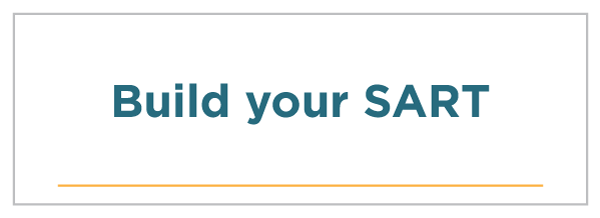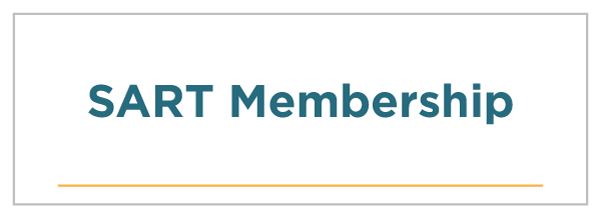
 |
 |
 |
 |
 |
Leadership structures on SARTs are just as unique as the jurisdictions and communities they serve. While SART champions may be SART leaders or members, establishing intentional leadership can be beneficial when attempting to formalize aspects of your team, strengthen relationships, address power dynamics, manage tasks, and hold members accountable.
Regardless of the makeup of your SART, understanding leadership roles and activities can be an extremely important aspect of the team’s functioning, especially to ensure sustainability through transition or turnover.
Leadership can look different in different communities. In one community, the public health officer chairs the SART and delegates various responsibilities while in another, there is a part-time coordinator who is also employed by the sheriff’s office.
Use this section of the SART Toolkit to refine tasks by established leadership, develop leadership, or explore completing leadership tasks with a less formal structure.
Some of the key leadership roles that support SART functioning are —
The activities commonly associated with each role are listed below, although these tasks may be shared among members.
The focus of a coordinator is to support the effective functioning of the team toward its mission.
Examples of key coordinator activities include the following:
Teams with a paid coordinator will also have a job description and likely some grant guidelines (or other requirements that may come with funding for the position) that also shape the coordinator’s activities.
Some teams divide the coordination activities among team members rather than hiring a coordinator. This can work well when team members communicate easily and frequently with one another and responsibilities for specific activities are clearly understood.
When a coordinator is also the only representative of a member agency, discuss how the team will ensure that the duties associated with both roles can be done well. Discuss expectations team members have for the coordinator and for each other to ensure the effectiveness for the team.
You may also consider rotating the coordination responsibilities. For example, just because the law enforcement officer has time today and for the next six months, that does not mean they will always have that time. Plan periodic check-ins or service terms to ensure that the coordination arrangement chosen continues to work for everyone.
A facilitator is typically assigned the role for a specific meeting or process such as visioning and planning, case review, conflict resolution, or group interviews. Sometimes a team member is identified for this role alone, and other times the coordinator or chairperson may also play this role.
Examples of key facilitator activities include the following:
Most people facilitate meetings within their agencies or at SART meetings without any specific facilitation training. SARTs are made up of multiple agencies with overlapping and complicated missions and priorities, so objective, trained facilitators can be invaluable in ensuring everyone’s voices are heard and that all members feel comfortable sharing their views.
A trained facilitator can be crucial to developing psychological safety where all team members feel respected and engaged. When the concerns and experiences of all team members are valued, better group decision-making develops.
Sometimes your team may want to bring in an outside facilitator for a meeting or process you are using. Other times, one of your own skilled team members may play this role. Consider choosing a team member to receive specific facilitator training.
For more information on facilitating team meetings, see the SART Meeting Logistics section. For more information on psychological safety, see the Creating Successful Team Norms section of the SART Toolkit.
The chairperson provides leadership during team meetings and is the face of the SART to agency leadership and within the community, sometimes in tandem with the coordinator.
Examples of key chairperson activities can include:
Some SARTs elect a team member to this role for a specific term (e.g. one year), while others rotate this position among members for a series of meetings. This role can be formal or informal as is fitting for the work and nature of the team.
Some SARTs find it helpful to separate the role of chairperson from that of a specific coordinator, as the coordinator may have other active roles in a team meeting, such as reporting on projects. It also expands accountability for the success of the team beyond one person.
A fiscal agent provides an administrative home for the SART for a given period, especially if it involves managing financial resources.
Examples of key fiscal agent activities can include the following:
Providing an administrative home for the SART is an important leadership role. The fiscal agent is often the primary voice for SARTs with funding agencies and others outside the local community. They also often shape the role of a coordinator and design the projects that get funded.
Fiscal agents are often the SART’s biggest champions. Effective collaboration between the fiscal agency leadership and other SART leadership is important for effectiveness and sustainability.
Subject matter experts provide information, insight, and questions based in an area of expertise. Every team member can bring this leadership to the team within their own area of knowledge. Additional experts may be invited in for short- or long-term participation around the work of the team as needed.
Examples of key activities for subject matter experts can include the following:
Every team member brings knowledge and expertise to the team about both the agency in which they work as well as their part of the response to sexual assault and working with victims or offenders.
Considering the range of what SARTs need to know (e.g. sexual assault and homelessness, barriers for Deaf and hard-of-hearing victims, investigating sexual assault of elders, prosecution of non-stranger sexual assault, victims’ experiences of local resources, approaches to offender treatment and monitoring, and forensic evidence collection), subject matter experts have a responsibility to share what they know and seek external support, clarification, or confirmation as needed.
Staying up to date in their field on new information is part of the leadership role of all team members. SARTs benefit greatly when team members commit themselves to bringing the best information to the team on behalf of their agency, discipline, and community.
The leaders of member agencies provide institutional supports for the team’s work, including representation on the team from staff knowledgeable about both sexual assault and the agency’s response. Leadership support provides a visible commitment to improving responses to sexual assault in coordination with the SART’s efforts.
These are examples of key activities for member agency leadership:
Clearly defined roles and expectations regarding leadership produces a stronger SART. Understanding what needs to be done and who is responsible for those tasks increases sustainability and prepares a SART for turnover, particularly when a key member leaves and the team feels the impact.
For some SARTs, assigning leadership roles among members helps clarify responsibilities, brings additional energy and ideas to the roles, and makes the roles more visible. Leadership teams may be official, unofficial, formal or informal.
To increase effectiveness, the leadership team can hold separate coordination meetings to discuss the direction of the SART, identify facilitation styles and issues, and provide feedback to one another.
In addition, leadership teams may hold periodic meetings with fiscal agency leadership and member agency leadership to discuss the direction of the SART, give and receive feedback, and consider ongoing funding obligations and opportunities.
When key SART members leave the team, it can be disruptive. While it can lead to a great opportunity for the team to gain the insight, energy, and experience of a new person, the change typically means a break in the way things have been done.
The best way to deal with inevitable leadership turnover is to prepare for it. This can include having written job descriptions for various leadership roles, keeping written records of agendas and minutes, developing an orientation for new team members, and having outgoing leaders meet with new leaders to orient them to the leadership role and highlight any notable issues requiring attention.
In turnover of significant positions, like a full-time paid coordinator, the team may also benefit from reviewing its work plan and making adjustments during the transition period.
All About Staffing — Hiring and Keeping the Best Employees
This staffing guide reviews workforce planning; outsourcing; recruiting, retaining, and screening applicants; volunteerism; and legal considerations.
Best Practices Guidelines: Crime Victim Services (PDF, 29 pages)
This guide from the Minnesota Department of Public Safety covers best practices in direct services, community partnerships, business practices, and leadership for crime victim service providers.
California SART Report: Taking Sexual Assault Response Teams to the Next Level (PDF, 158 pages)
Page 94 of this report discusses SART leadership, particularly promising practices around succession and development. There are also a few case studies presented as examples of leaders who are champions for SARTs.
Free Basic Guide to Leadership and Supervision
This guide reviews core management skills, staffing, employee training, employee performance management, and personnel policies.
Multidisciplinary Team Leaders: What Is the Role of the Coordinator? (multimedia, 1:29)
This webinar from the Sexual Violence Justice Institute at Minnesota Coalition Against Sexual Assault discusses the role of a SART leader/coordinator, including critical elements necessary for the position.
Sexual Assault Response Team (SART) Coordinator (PDF, 2 pages)
This sample job description by Tu Casa, Inc. for a SART coordinator provides a starting point for SARTs to develop a coordinator job description.
| Back | Index | Next |
